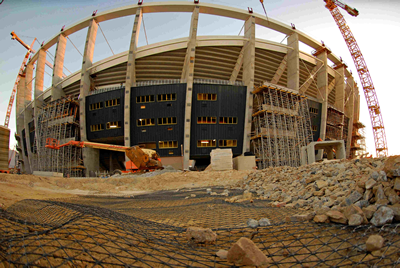 16 April 2010 – Tensar International’s TriAx™ geogrid has been successfully installed by South African World Cup 2010 contractors to overcome poor load-bearing ground encountered on the new Green Point Stadium in Cape Town.
16 April 2010 – Tensar International’s TriAx™ geogrid has been successfully installed by South African World Cup 2010 contractors to overcome poor load-bearing ground encountered on the new Green Point Stadium in Cape Town.
Construction of the stadium, which will play host to a World Cup semi-final in July, was made problematic by the highly variable soil inherent to this spectacular ocean-side setting at the southern tip of the continent.
Led by the joint venture of Murray and Roberts and WHBO, the new 68,000-seater stadium was designed to be set into a deep excavation, to satisfy planning constraints relating to nearby buildings. Initial problems were encountered as a result of the excavated material being placed uncompacted over surrounding spaces. So, when temporary haul roads for access were routed over these areas, considerable ground movement was experienced.
As some of these roads would become permanent roads for stadium access, the routes needed stabilising and because of the tight programme it was decided to carry this out early with the advantage that the haul roads would also benefit.
The contractor had a choice of removing 6-8 metres of the fill, replacing it with properly compacted fill and bringing up to level, or constructing a mechanically stabilised road base with two layers of TriAx™ geogrid and 400mm of locally-sourced high-quality aggregate.
Choosing TriAx™ to reduce time and cost, this solution was deemed a success following extensive use over an exceptionally difficult winter. Even severe rain, including a 58mm/hour storm, resulted in minimal settlement or deformation of the new access road.
As a result of the project success, Tensar TriAx™ was also used by the contractors to provide localised load bearing support for parts of the stadium.
For example, under the Grand Staircase entrance up to the stadium podium, TriAx™ was used to reduce the required thickness of the proposed aggregate fill in the upper layers, speeding the construction and saving on imported aggregate.
At another point of the Grand Staircase, TriAx™ was used to reinforce the bedding under the steps and reduce any differential settlement which might compromise the structure and require remediation.
Finally, where the ground slopes away towards the sea, a large block paved area was constructed with concrete retaining walls capped by cast ‘jockey slabs’; these comprised cast concrete slabs placed along the perimeter of the wall, bridging the outer layer of fill and the compacted fill completing the base layer to the paving blocks.
A Tensar TriAx™ mechanically stabilised layer was installed beneath the jockey slabs to mitigate any differential settlement between the slabs and the fill, and prevent a shear line appearing in the block paving cover layer, which is a common occurrence during this form of construction.
Tony Roe, Tensar International’s Africa and Middle East Export Sales Manager, commented: “This is a prestigious and very high-profile $400 million project, so both the client and contractors were under pressure to overcome the issues presented by the location and delivery timings.”
“With our local civil engineering contacts we were able to provide TriAx™ geogrid solutions, which prevented delays and improved the final quality of the construction.”
Client: Murray and Roberts / WHBO Joint Venture
Consultant: BKS (PTY) Ltd.
Groundworks Contractor: Martin and East (PTY) Ltd
For copies of Tensar International’s brochure, please visit www.tensar.co.uk.
ADDITIONAL LINK
Tensar International Profile on Geosynthetica











